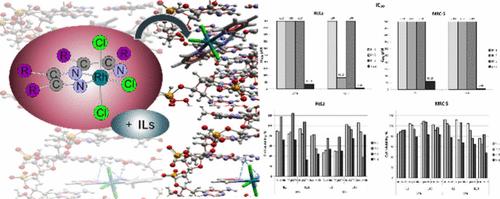用离子液体增强 N,N,N-螯合铑(III)配合物的生物活性:实现癌症靶向治疗
IF 6.8
1区 医学
Q1 CHEMISTRY, MEDICINAL
引用次数: 0
摘要
本研究探讨了使用离子液体作为共溶剂提高难溶性铑(III)配合物的溶解度和活性的潜力,特别是那些含有二烯、吡啶衍生物和樟脑衍生双吡唑吡啶配体的配合物与 5′-GMP、CT-DNA 和 HSA 的关系及其生物活性。研究结果表明,离子液体能显著提高这些复合物对 5′-GMP 的取代活性,而分子对接对 DNA/HSA 的结合亲和力影响甚微,这进一步证实了实验结果。亲脂性评估表明这些复合物具有良好的亲脂性。值得注意的是,细胞毒性研究表明,Rh2 对 HeLa 癌细胞具有选择性效果,IL1 和 IL10 可调节细胞毒性效果。氧化还原评估表明,铑复合物在癌细胞中诱导氧化应激,而在非癌细胞中维持氧化还原平衡。通过阐明离子液体在调节这些效应中的作用,该研究为提高癌症治疗的疗效和选择性提供了一个前景广阔的途径,从而为癌症治疗开辟了新的前景。本文章由计算机程序翻译,如有差异,请以英文原文为准。

Enhancing Bioactivity of N,N,N-Chelating Rhodium(III) Complexes with Ionic Liquids: Toward Targeted Cancer Therapy
This study investigates the potential of using ionic liquids as cosolvents to enhance the solubility and activity of poorly soluble rhodium(III) complexes, particularly those with diene, pyridine derivatives, and camphor-derived bis-pyrazolylpyridine ligands, in relation to 5′-GMP, CT-DNA, and HSA as well as their biological activity. Findings indicate that ionic liquids significantly increase the substitution activity of these complexes toward 5′-GMP while only marginally affecting DNA/HSA binding affinities with molecular docking, further confirming the experimental results. Lipophilicity assessments indicated good lipophilicity. Notably, cytotoxicity studies show that Rh2 is selectively effective against HeLa cancer cells, with IL1 and IL10 modulating the cytotoxic effects. Redox evaluations indicate that rhodium complexes induce oxidative stress in cancerous cells while maintaining redox balance in noncancerous cells. By elucidating the role of ionic liquids in modulating these effects, the study proposes a promising avenue for augmenting the efficacy and selectivity of cancer treatments, thus opening new horizons in cancer therapeutics.
求助全文
通过发布文献求助,成功后即可免费获取论文全文。
去求助
来源期刊

Journal of Medicinal Chemistry
医学-医药化学
CiteScore
4.00
自引率
11.00%
发文量
804
审稿时长
1.9 months
期刊介绍:
The Journal of Medicinal Chemistry is a prestigious biweekly peer-reviewed publication that focuses on the multifaceted field of medicinal chemistry. Since its inception in 1959 as the Journal of Medicinal and Pharmaceutical Chemistry, it has evolved to become a cornerstone in the dissemination of research findings related to the design, synthesis, and development of therapeutic agents.
The Journal of Medicinal Chemistry is recognized for its significant impact in the scientific community, as evidenced by its 2022 impact factor of 7.3. This metric reflects the journal's influence and the importance of its content in shaping the future of drug discovery and development. The journal serves as a vital resource for chemists, pharmacologists, and other researchers interested in the molecular mechanisms of drug action and the optimization of therapeutic compounds.
 求助内容:
求助内容: 应助结果提醒方式:
应助结果提醒方式:


